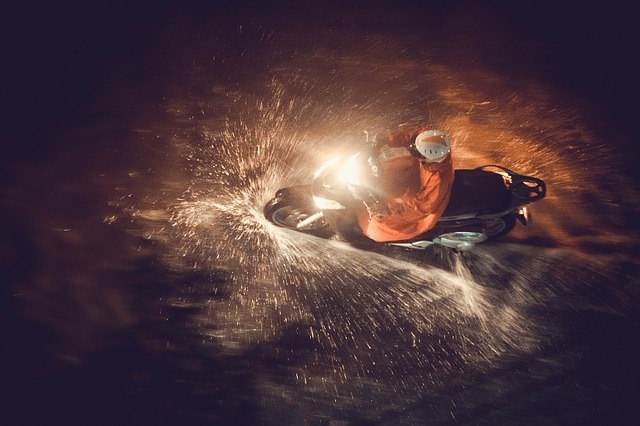No matter how careful you are about checking out the forecast before you ride, eventually you will be hit by a downpour. Even a little rain can make roads more dangerous for bikers, and heavy rains just compound the problem. Fortunately, there are a number of tips for riding your motorcycle in the rain. Check out these 20 tips before you hear the thunder roll!
Motorcycle Rain Safety Riding Tips
1. Roads are slickest when the rain or storm first begins, especially if it hasn’t rained in a while. Oil and dirt build up on the roads and mix with the rain to produce super-slick surfaces. It’s always best to avoid the roads when the rain first begins to fall. If you can’t put your ride off, at least be extra vigilant that road surfaces will be especially slick during this time. Oil and debris generally wash away after it has been raining heavily for a few minutes. Just remember to take it slow and easy.
2. Allow extra braking distance between you and others on the road. Stopping distances increase in wet weather, so increase the buffer space between your bike and other vehicles. Also, remember that you will need extra distance to stop when approaching an intersection. Dry pavement is ideal for braking, but wet roads increase stopping distances significantly. All vehicles require extra braking distance on wet surfaces, but this is especially true when you ride a motorcycle.
3. When you do apply your brakes, do so gently. If you need to apply your brakes suddenly, pump them in order to prevent hydroplaning. Do not apply just your front brakes as it can cause you to lose control of the front wheel.
4. Apply more rear brake than usual. If your front wheel starts skidding, you are in trouble. If your back wheel does, you can always correct.
5. Keep an eye out for puddles and avoid riding through them. Puddles can mask potholes and damage to the surface of the road. Also, there’s no way to tell from the surface of a puddle just how deep it is. It’s best to avoid temptation and steer clear of the puddles!
6. Painted surfaces are especially slick. Avoid painted lines and road surfaces as you’re likely to slide. Also, be aware of tar snakes on the road. These are areas where cracks on the pavement are filled with a tar-like sealant that becomes particularly slick in wet conditions.
7. Rain and moisture in the air can cause your helmet to fog up. Never try to ride with a fogged up helmet. Instead, pull over and wipe it off. Use an anti-fogging spray to help prevent this from occurring.
8. Don’t ride in the rain with slick tires. Make sure your tires are appropriate for rainy conditions and have plenty of tread left.
9. Wear appropriate rain gear to stay dry while staying safe. Choose a fabric that is waterproof and windproof, but still breathable. Be sure your helmet protects your face, as well, as rain can feel like needles at high speeds. A warm jacket can keep you comfortable in cold, rainy weather. But even if it is warm outside, a jacket can keep you dry. Anti-fogging products can be applied to your visor, as well.
10. Wear bright gear for better visibility. Rain conditions are notoriously dark and dismal, and it’s easy to blend into the road. Make yourself seen with bright colors and reflective surfaces.
11. Stay aware of weather conditions. Flooded roads and windy conditions can be treacherous for bikers. Make sure you have a weather app set to notify you of any weather warnings in your area.
12. Ride in a dry line. Whenever possible, find the dry line that remains from the tire tread of the vehicle in front of you. The tire acts to push the water out of the way, so you get to ride on a dryer surface.
13. Use a waterproof bag or pocket for anything that could get damaged by water, like your cell phone or electronics. Even cases that are promoted as water-resistant can result in a loss if water infiltrates the case. Better to be safe than sorry.
14. Maintain a calm, relaxed posture. It’s normal to tighten your muscles when you are faced with a difficult situation, like riding your motorcycle in the rain. Try to keep your muscles relaxed and maintain a normal posture. Tightening your muscles will your body and mind tense, and could make you overreact to changing situations.
15. Slow down. It goes without saying that if you are riding in the rain, you should slow down. Rainy conditions impact visibility and stopping distance – so slow down In order to stay safe and give yourself (and others) enough time to make decisions.
16. Never ride in a thunderstorm. Watch out for lightning and pull off to the side of the road if you see it. Find shelter, but not under a tree! Now is a great time to pull off and have a cup of coffee.
17. Rainy conditions are often windy conditions. Be aware of the impact of the wind on your bike. Be alert for signs of winds and duck down with your arms and legs tight. It can be tempting to ride next to a large truck to block the wind, but remember the effect will be reversed when the truck passes you.
18. Take frequent breaks. Riding your motorcycle in the rain, especially for an extended period of time, is exhausting. Take regular breaks and stretch your legs. This will keep you limber and able to respond quickly if needed.
19. Watch for fog. Foggy and misty areas decrease visibility. Use your low beam headlight and fog lights. Avoid your high beam headlight which can reflect light back and produce glare.
20. Wear waterproof gloves. This is more about comfort than safety, but riding with wet hands is miserable. Find a rain glove with a waterproof liner with sealed seams. If you prefer a leather glove, make sure it’s waterproof, not water resistant, or otherwise, the moisture can still seep in.
For a free legal consultation,
call 1-800-668-6729
In a Motorcycle Accident When Riding in the Rain?
If you ride a motorcycle in the rain, your chance of being involved in a collision increases. This is due to the hazards associated with riding in wet weather. It is essential that you take proper precautions to prevent a motorcycle crash from occurring. But even if you follow all of the tips listed above, motorcycle accidents can still happen. Often, they are due to the negligence of others on the road.
If you have been in a motorcycle crash, whether due to riding in the rain or for any reason, contact the Law Firm of Kass & Moses. Call today and speak with an experienced motorcycle accident attorney about your options. We have represented injured bikers for decades and can help you secure just, fair compensation for your injuries.
Safe riding in the rain increases your risk of being involved in a motorcycle crash, so exercise the above precautions to help keep you safe.
For more safety tips, motorcycle trends, and the best bikes follow our Facebook page!
Call or text 1-800-668-6729 or complete a Free Case Evaluation form


